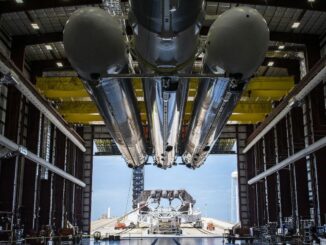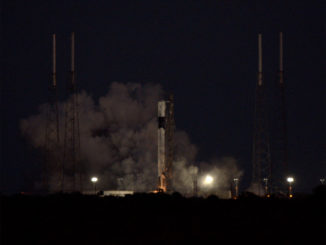
United Launch Alliance teams ran through an 11-hour countdown Friday at Cape Canaveral to rehearse procedures before the first flight of a modified Atlas 5 rocket with Boeing’s Starliner crew capsule Dec. 20.
The 172-foot-tall (54.2-meter) launcher was filled with super-cold cryogenic propellants Friday morning at Cape Canaveral’s Complex 41 launch pad, and a “Blue Team” of ULA and Boeing technicians climbed the crew access tower at pad 41 to practice the preparations they will execute on launch day.
The Blue Team is analogous to the NASA closeout crew that helped astronauts get into their seats during the Apollo and space shuttle programs.
The Integrated Day-of-Launch Test, or IDOLT, Friday was a major milestone leading up to the launch of Boeing’s Starliner Orbital Flight Test, an unpiloted mission to the International Space Station. The Orbital Flight Test, expected to last about a week, is a shakedown cruise for Boeing’s new crew capsule before NASA approves its astronauts to fly on the Starliner’s Crew Flight Test next year.
The launch of the Orbital Flight Test is scheduled for Dec. 20, a day later than Boeing and ULA previously announced. The launch time Dec. 20 is set for 6:36 a.m. EST (1136 GMT).
In a statement after Friday’s countdown exercise, ULA said the one-day weather delay of a SpaceX resupply launch to the space station earlier this week prevented teams from performing the day-of-launch test as planned Thursday, triggering a one-day delay in the launch date to Dec. 20. SpaceX’s Falcon 9 rocket was scheduled to launch Wednesday, but out-of-limits upper level winds kept the mission grounded until Thursday.
The Falcon 9 launched from pad 40, a little more than a mile away from the Atlas 5 launch complex. Both pads were originally constructed for the U.S. Air Force Titan rocket program, and they continue to share some infrastructure resources, limiting simultaneous countdown operations.
A peek inside the @Commercial_Crew Access Arm white room as our team practices preparing #Starliner for OFT during our Integrated Day of Launch Test. This practice is important. On launch day, this team has to have everything done right on time or we’re not flying. pic.twitter.com/cZoer0Rbj1
— Boeing Space (@BoeingSpace) December 6, 2019
The Atlas 5 countdown for Starliner missions has been extended from a period of nearly seven hours to more than 11 hours. The longer countdown will give astronauts time to board the Starliner spacecraft.
Mimicking the timeline on a real launch day, ULA loaded liquid oxygen into the Atlas 5’s first stage Friday, and a combination of liquid hydrogen and liquid oxygen was loaded into the Atlas 5’s dual-engine Centaur upper stage.
The first stage’s fuel load of RP-1 rocket-grade kerosene was pumped aboard the rocket earlier this week, following its transfer from ULA’s Vertical Integration Facility to pad 41.
Once the rocket was fully fueled, the Atlas 5 was placed into a stable replenish mode, in which the super-cold propellants continued to slowly flow into the vehicle to replace that which boils off during the countdown.
It is at this point in the countdown when astronauts would climb inside the Starliner spacecraft, using the pad’s crew access tower and a retractable arm.
A little more than 10 minutes before the simulated liftoff time Friday afternoon, the crew access arm was retracted into position for launch. ULA’s launch team aborted the countdown as clocks reached zero.

ULA’s Atlas 5 team supported Friday’s countdown exercise inside the Atlas Spaceflight Operations Center at Cape Canaveral Air Force Station. Boeing engineers at the Florida spaceport monitored the Starliner’s status from a separate control room.
With the launch day exercise now complete, the Atlas 5 will be rolled back inside the Vertical Integration Facility this weekend for final testing and closeouts. NASA, Boeing and ULA will convene a major flight readiness review late next week for Starliner’s Orbital Flight Test.
The Atlas 5 is scheduled to return to the launch pad Dec. 18 in preparation for the early morning launch opportunity Dec. 20.
After launch, the Atlas 5 will deploy the Starliner capsule on a suborbital trajectory, and the ship’s on-board thrusters will maneuver the spacecraft into a preliminary orbit to begin pursuit of the space station.
The Starliner will perform an automated docking with the space station’s Harmony module, and astronauts aboard the station will open hatches to enter the Boeing crew capsule for safety checks and to unpack some cargo slated for delivery on the Orbital Flight Test.
The capsule will detach from the station after about one week, targeting a parachute-assisted and airbag-cushioned landing in the Western United States. Weather permitting, the primary landing site for the unpiloted test flight this month will be at White Sands Space Harbor in New Mexico.
Email the author.
Follow Stephen Clark on Twitter: @StephenClark1.



